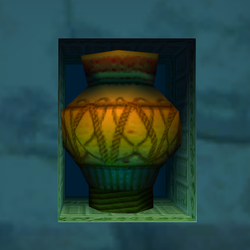Jar
- This article is about the objects that commonly appear in Super Mario Bros. 2. For the treasure in Wario Land 3, see Out of the Woods § Red Chest: Jar. For the obstacles in the Mario Kart series, see Jar (Mario Kart series).
| Jar | |
|---|---|

| |
| First appearance | Yume Kōjō: Doki Doki Panic (1987, overall) Super Mario Bros. 2 (1988, Super Mario franchise) |
| Latest appearance | Nintendo World Championships: NES Edition (2024) |
| Effect | Transports players to other areas |
Jars,[1][2][3] also known as pipes,[4][5] pots,[6][7] or vases,[8] appear in the Super Mario franchise as platforms or interactive objects that can be entered in the manner of a Warp Pipe.
HistoryEdit
Super Mario seriesEdit
Yume Kōjō: Doki Doki Panic / Super Mario Bros. 2 / Super Mario AdvanceEdit
Jars in Yume Kōjō: Doki Doki Panic and Super Mario Bros. 2 are the main modes of transportation of Subcon, and if a character goes down a jar, they will appear in a small room sometimes containing a key being protected by a Phanto. Jars in certain levels within Subspace contain a Subspace Warp that warps the player character to a certain later world. A door from a Magical Potion cannot be spawned inside of a jar. Cobrats sometimes lurk in the openings of some jars. Certain jars are Shy Guy Generators[9] and Bob-Omb Generators,[10] which generate endless streams of red Shyguys or Bob-Ombs, respectively, unless their entrances are blocked. In Super Mario Advance, some jars also contain Sparks and Spark Chasers, as well as (sometimes Shyguy-ridden) Ferris wheel platforms, and one contains a bouncing blade; jars were also added to levels in that version, and certain closed-off jars in previous versions were opened.
BS Super Mario USAEdit
Jars in BS Super Mario USA are used identically as in Super Mario Bros. 2, except jars in Subspace lead to a battle against Wart.
Super Mario SunshineEdit
Jars[11] in Super Mario Sunshine appear a hidden room in Noki Bay, underneath Gooper Blooper's boss arena, and one of the two largest jars releases a blue coin when sprayed at.
Super Smash Bros. seriesEdit
Jars in the Super Smash Bros. series appear in the background of the Mushroom Kingdom II stage in Super Smash Bros. Melee and Super Smash Bros. Ultimate.
Mario Pinball LandEdit
Jars in Mario Pinball Land appear on the first pyramid interior board of the Shifting Sands Stage. There are four jars, which have earthy colors and diamond shapes on their pattern. They cannot be interacted with as their corners are elevated, but Snakes come out of them if the middle floor panel is activated.
Princess Peach: Showtime!Edit
Pots appear in various levels in Princess Peach: Showtime!, most commonly in the Ninja Peach, Kung Fu Peach and Swordfighter Peach levels. If Peach breaks the pots, they can either be empty or contain coins, Sparkle Gems or the Ribboner.
In Ninjutsu: The Art of Rapids the Ribboner has ended up in a pot on purpose, claiming he has mastered the "ancient ninja art: the pot-hide technique." On all later occasions where he has ended up in or behind pots he has done so by accident and wants to be rescued by Peach.
Certain sections in the Kung Fu Peach levels have a specific subcategory of the Sour Bunch who throw pots at Peach, which damages her if they hit her, and in Kung Fu Rehearsal a pot hit on Peach will instantly end the level.
GalleryEdit
Super Mario All-Stars (Super Mario Bros. 2)
Princess Peach: Showtime! (Swordfighter design)
Names in other languagesEdit
| Language | Name | Meaning |
|---|---|---|
| Japanese | Tsubo |
Pot |
| Chinese (simplified) | 瓶子[13] Píngzi |
Vase |
| German | Vase |
Vase |
| Italian | Vaso[14][15] Giara[16] Mini Giara[16] (generator) |
Pot Jar Mini Jar |
ReferencesEdit
- ^ Nintendo (1988). Super Mario Bros. 2 instruction booklet. Nintendo of America (American English). Page 25.
- ^ 1993. Super Mario All-Stars Player's Guide. Nintendo of America (American English). Page 89.
- ^ Nintendo (2001). Super Mario Advance instruction booklet. Nintendo of America (American English). Page 33.
- ^ 1993. Super Mario All-Stars Player's Guide. Nintendo of America (American English). Page 87.
- ^ Stratton, Bryan (June 7, 2001). Super Mario Advance Prima's Official Strategy Guide. Prima Games (American English). ISBN 0-7615-3633-7. Page 8.
- ^ Nintendo PlayChoice-10 Super Mario Bros. 2 instructions
- ^ 1993. Super Mario All-Stars Player's Guide. Nintendo of America (American English). Page 96.
- ^ Nintendo (2001). Super Mario Advance instruction booklet. Nintendo of America (American English). Page 25.
- ^ Stratton, Bryan (June 7, 2001). Super Mario Advance Prima's Official Strategy Guide. Prima Games (American English). ISBN 0-7615-3633-7. Page 39, 40, 59, 60, 63, 64, 73, 74, 76, 87.
- ^ Stratton, Bryan (June 7, 2001). Super Mario Advance Prima's Official Strategy Guide. Prima Games (American English). ISBN 0-7615-3633-7. Page 58, 59, 69, 76.
- ^ Averill, Alan and Jennifer Villarreal (2002). Super Mario Sunshine: The Official Nintendo Player's Guide. Redmond: Nintendo of America. ISBN 1-930206-23-2. Page 124.
- ^ Nintendo (1987). Yume Kōjō: Doki Doki Panic instruction booklet. Nintendo (Japanese). Page 34.
- ^ SMG114514 (February 27, 2017). 小神游GBA官方游戏宣传视频. Bilibili (Simplified Chinese). Retrieved June 4, 2024.
- ^ Super Mario Bros. 2 Italian manual. Page 25.
- ^ Nintendo (2001). Super Mario Advance manual. Nintendo of Europe (Italian). Page 109.
- ^ a b November 15, 2018. Super Mario Bros. Enciclopedia. Magazzini Salani (Italian). ISBN 889367436X. Page 70.
